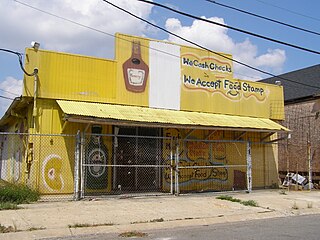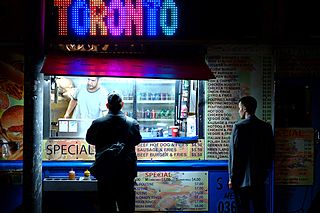
Convenience food is food that is commercially prepared for ease of consumption, and is usually ready to eat without further preparation. It may also be easily portable, have a long shelf life, or offer a combination of such convenient traits. Convenience foods include ready-to-eat dry products, frozen food such as TV dinners, shelf-stable food, prepared mixes such as cake mix, and snack food. Food scientists now consider most of these products to be ultra-processed foods and link them to poor health outcomes.

Urban agriculture refers to various practices of cultivating, processing, and distributing food in urban areas. The term also applies to the area activities of animal husbandry, aquaculture, beekeeping, and horticulture in an urban context. Urban agriculture is distinguished from peri-urban agriculture, which takes place in rural areas at the edge of suburbs.
Nutrition transition is the shift in dietary consumption and energy expenditure that coincides with economic, demographic, and epidemiological changes. Specifically the term is used for the transition of developing countries from traditional diets high in cereal and fiber to more Western-pattern diets high in sugars, fat, and animal-source food.
Obesity in Mexico is a relatively recent phenomenon, having been widespread since the 1980s with the introduction of ultra-processed food into much of the Mexican food market. Prior to that, dietary issues were limited to under and malnutrition, which is still a problem in various parts of the country. Following trends already ongoing in other parts of the world, Mexicans have been foregoing the traditional Mexican diet high in whole grains, fruits, legumes and vegetables in favor of a diet with more animal products and ultra-processed foods. It has seen dietary energy intake and rates of overweight and obese people rise with seven out of ten at least overweight and a third clinically obese.
Social epidemiology focuses on the patterns in morbidity and mortality rates that emerge as a result of social characteristics. While an individual's lifestyle choices or family history may place him or her at an increased risk for developing certain illnesses, there are social inequalities in health that cannot be explained by individual factors. Variations in health outcomes in the United States are attributed to several social characteristics, such as gender, race, socioeconomic status, the environment, and educational attainment. Inequalities in any or all of these social categories can contribute to health disparities, with some groups placed at an increased risk for acquiring chronic diseases than others.

Supermarket shortages have been identified in many American urban neighborhoods, and such gaps in food access have been closely correlated with diet-related diseases such as cancer, obesity, and diabetes. The shortage began when many supermarkets left mixed-income central city neighborhoods after civil disturbances in the late 1960s and 1970s. By 1984, store openings exceeded closings nationally, but the opposite held in cities; and the trend continues. The reluctance of large chains to open in urban areas is termed by some activists, "supermarket redlining."

While genetic influences are important to understanding obesity, they cannot explain the current dramatic increase seen within specific countries or globally. It is accepted that calorie consumption in excess of calorie expenditure leads to obesity; however, what has caused shifts in these two factors on a global scale is much debated.
Based in Washington, D.C., Leadership for Healthy Communities is a $10-million national program of the Robert Wood Johnson Foundation designed to engage and support local and state government leaders nationwide in their efforts to advance public policies that support healthier communities and prevent childhood obesity. The program places an emphasis on policies with the greatest potential for increasing sustainable opportunities for physical activity and healthy eating among children at highest risk for obesity, including African-American, Latino, American Indian and Alaska Native, Asian-American and Pacific Islander children living in lower-income communities. The foundation's primary goal is the reversal of the childhood obesity epidemic by 2015.

Social class differences in food consumption refers to how the quantity and quality of food varies according to a person's social status or position in the social hierarchy. Various disciplines, including social, psychological, nutritional, and public health sciences, have examined this topic. Social class can be examined according to defining factors — education, income, or occupational status — or subjective components, like perceived rank in society.

Hunger in the United States of America affects millions of Americans, including some who are middle class, or who are in households where all adults are in work. The United States produces far more food than it needs for domestic consumption—hunger within the U.S. is caused by some Americans having insufficient money to buy food for themselves or their families. Additional causes of hunger and food insecurity include neighborhood deprivation and agricultural policy. Hunger is addressed by a mix of public and private food aid provision. Public interventions include changes to agricultural policy, the construction of supermarkets in underserved neighborhoods, investment in transportation infrastructure, and the development of community gardens. Private aid is provided by food pantries, soup kitchens, food banks, and food rescue organizations.

The Food Desert Oasis Act of 2009 or H.R. 3100 (111th) was introduced in the US House of Representatives on June 26, 2009 by Rep. Bobby Rush [D-IL 1]. Rep. Rush introduced the bill to establish the Food Desert Oasis Pilot Program, intended to combat food deserts. A food desert defined by the United States Department of Agriculture's Healthy Food Financing Initiative working group, is a "low income census tract where a substantial number or share of residents has low access to a supermarket or large grocery store." The bill identifies several US cities as food desert zones, defines a qualified food desert business, grants certain tax benefits for those designated food deserts, amends the Food Conservation and Energy Act of 2008 and directs the Secretary of the Treasury to report on the health of such communities. The bill did not come to a vote and did not become law, but other federal initiatives have been created to address food deserts.
Phat Beets Produce is an American food justice collective focusing on food justice in North Oakland, California, started by Max Cadji and Bret Brenner in 2007. Their programs include weekly farmer's markets, free produce stands, youth gardens, community supported agriculture programs, food and social justice workshops, and previously, a kitchen and cafe cooperative. Cadji helps residents have access to nutritious food by coordinating between farmers, institutions, and low-income communities to utilize empty land for urban gardening.

Obesity and the environment aims to look at the different environmental factors that researchers worldwide have determined cause and perpetuate obesity. Obesity is a condition in which a person's weight is higher than what is considered healthy for their height, and is the leading cause of preventable death worldwide. Obesity can result from several factors such as poor nutritional choices, overeating, genetics, culture, and metabolism. Many diseases and health complications are associated with obesity. Worldwide, the rates of obesity have nearly tripled since 1975, leading health professionals to label the condition as a modern epidemic in most parts of the world. Current worldwide population estimates of obese adults are near 13%; overweight adults total approximately 39%.
The eating culture of the Navajo Nation is heavily influenced by the history of its people. The Navajo are a Native American people located in the southwestern United States whose location was a major influence in the development of their culture. As such, New World foods such as corn, boiled mutton, goat meat, acorns, potatoes, and grapes were used widely by the Navajo people prior to and during European colonization of the Americas.

Food security in the Central Valley, California, United states is a widespread issue. The Central Valley is where most of the state's and the nation's agriculture is produced. Despite this, many people living and working in the valley's agriculture industry are food insecure in some way, with contributing factors including lack of food sources, lack of healthy food choices, or income barriers. About a third of many Central Valley counties' populations were documented as food insecure in 2009. Due to the lack of healthy food choices, high rates of obesity have also been found in the Central Valley.
The Food Justice Movement is a grassroots initiative which emerged in response to food insecurity and economic pressures that prevent access to healthy, nutritious, and culturally appropriate foods. The food justice movement moves beyond increasing food availability and works to address the root cause of unequal access to adequate nutrition. Like other Environmental Justice initiatives, the Food Justice Movement advocates for rights-based solutions that identify the underlying human rights that allow individuals to achieve adequate food security and nutrition. This differs from policy-based solutions that focus on food availability and affordability by increasing food production or lowering the cost of food.

This is a list of food desert issues and solutions by country.
The Healthy Food Financing Initiative (HFFI) is a program created in 2010 by the Obama administration as part of the Let's Move! public health campaign. It is a partnership between the Department of Health and Human Services, the Treasury Department, and the Department of Agriculture, which seeks to address inequality in food access, and encourage the growth of food retailers such as grocery stores and farmer's markets in so-called food deserts, where there is limited availability of healthy food options, and a community over-reliance on fast food and convenience stores. To address this, the program provides "financing to grocers or real estate developers seeking to open or expand stores in areas without adequate access to affordable, nutritious foods."

A food swamp is an urban environment with few grocery stores but several non-nutritious food options such as corner stores or fast-food restaurants. One definition gives a general ratio of four unhealthy options for each healthy option. The term was first coined by researchers conducting longitudinal studies of the link between increased access to grocery stores and rising obesity rates. Rose and colleagues in this study found that even with a new access to local grocery stores, the proportion of convenience stores and fast food to a single grocery store did not shift food choices nor obesity rates. This indicates that food swamps are separate from food deserts.

Food deserts are generally defined as regions that lack access to supermarkets and affordable, healthy foods, particularly in low-income communities. According to the USDA's most recent report on food access, as of 2017, approximately 39.5 million people - 12.9% of the US population - lived in low-income and low food access.
















